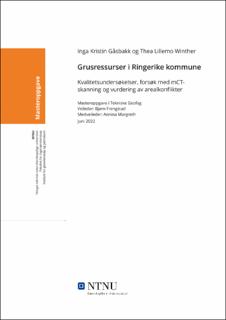| dc.contributor.advisor | Frengstad, Bjørn | |
| dc.contributor.advisor | Margreth, Annina | |
| dc.contributor.author | Gåsbakk, Inga Kristin | |
| dc.contributor.author | Winther, Thea Lillemo | |
| dc.date.accessioned | 2022-12-10T18:19:39Z | |
| dc.date.available | 2022-12-10T18:19:39Z | |
| dc.date.issued | 2022 | |
| dc.identifier | no.ntnu:inspera:114862279:37277225 | |
| dc.identifier.uri | https://hdl.handle.net/11250/3037093 | |
| dc.description.abstract | Ringerike kommune er rik på byggeråstoffer, spesielt grus. Kommunen har tre forekomster av nasjonal betydning som er viktig for nasjonal forsyning. Kommunen må være flink til å prioritere riktig slik at viktige ressurser blir utnyttet på korrekt måte. Byggeråstoffer er en mangelvare flere steder, og kreves til både veibygging og boligbygging. Tilslag er hovedkomponenten i betong og vei, og kvaliteten på tilslaget er derfor avgjørende for kvaliteten på det ferdige produktet. Massene fra Hensmoen og Kilemoen er godt egnet som betongtilslag og lavkvalitetslagene i veibygging.
mCT-skanning er en ny metode som kan brukes for å bestemme kornfordeling. Det blir nå brukt for å analysere kjerneprøver i petroleumsbransjen, men denne metoden er relativt ny til bruk på løsmasseprøver for å finne kornfordeling. I dette tilfellet fungerte ikke mCT-skanningen for å lage kornfordeling. Maskinen som ble brukt er ikke optimal for slike typer prøver; prøvene var for store og kun et lite område av prøven ble analysert. Det har potensiale for å bli en effektiv metode for å finne kornfordelingen, dersom det brukes en mCT-maskin som med riktige innstillinger gir en tilstrekkelig oppløsning.
Ved å gjennomføre en GIS - analyse kan en undersøke tilgjengeligheten for fremtidige masseuttak og estimere volumet. NGU jobber med en ny beregningsmodell for å gjøre dette mer automatisk. Denne modellen skal ta i betrakning de forskjellige aspektene og konfliktområdene for grus- og pukkforekomster, som kvalitet, plassering, bebyggelse og reguleringer. De tre forekomstene av nasjonal betydning i Ringerike kommune har et samlet volum på ca 150 mill. m^3. Den årlige produksjonen på Hensmoen og Kilemoen er til sammen 780 000 tonn. Arealkonflikter hindrer uttak av masser på Eggemoen. Datasettene i GIS har noen unøyaktigheter, men de er såpass små at det ikke vil utgjøre store feil når det er snakk om forekomster med store arealer. | |
| dc.description.abstract | Ringerike municipality is rich in building materials, especially gravel. The municipality has three deposits of national significance that is important for national supply. The municipality must be good at prioritizing accurately so that important resources are utilized correctly. Building materials are in short supply in several places, and is required for both road construction and housing construction. Aggregate is the main component in concrete and in roads, and the quality of the aggregate is therefore crucial for the quality of the finished product. The masses from Hensmoen and Kilemoen are well suited as concrete aggregates and low-quality layers in road construction.
mCT scanning is a new method that can be used to determine grain distribution. It is now used to analyze core samples in the petroleum industry, but this method is relatively new for finding grain distribution. In this case, it was not successful using mCT scan for finding the grain distribution. The machine that was used is not optimal for these samples; the samples were too large and only a small area of the sample was analyzed. It has the potential to be an effective method for finding the grain distribution, if an mCT machine is used with the correct input which provide an adequate resolution.
By conducting a GIS analysis, one can examine the availability of future mass excavations and estimate the volume. NGU is working on a new calculation model to do this more automatic. This model should take into account the different aspects and areas of conflict for gravel and crushed stone deposits, such as quality, location, buildings and regulations. The three deposits of national significance in Ringerike municipality have a total volume of about 150 mill.m^3. The annual production at Hensmoen and Kilemoen is a total of 780,000 tonnes. Area conflicts prevents the extraction of masses on Eggemoen. The datasets in GIS have some inaccuracies, but they are small enough so that it will not constitute major errors when it comes to deposits with large areas. | |
| dc.language | nob | |
| dc.publisher | NTNU | |
| dc.title | Grusressurs i Ringerike kommune | |
| dc.type | Master thesis | |
